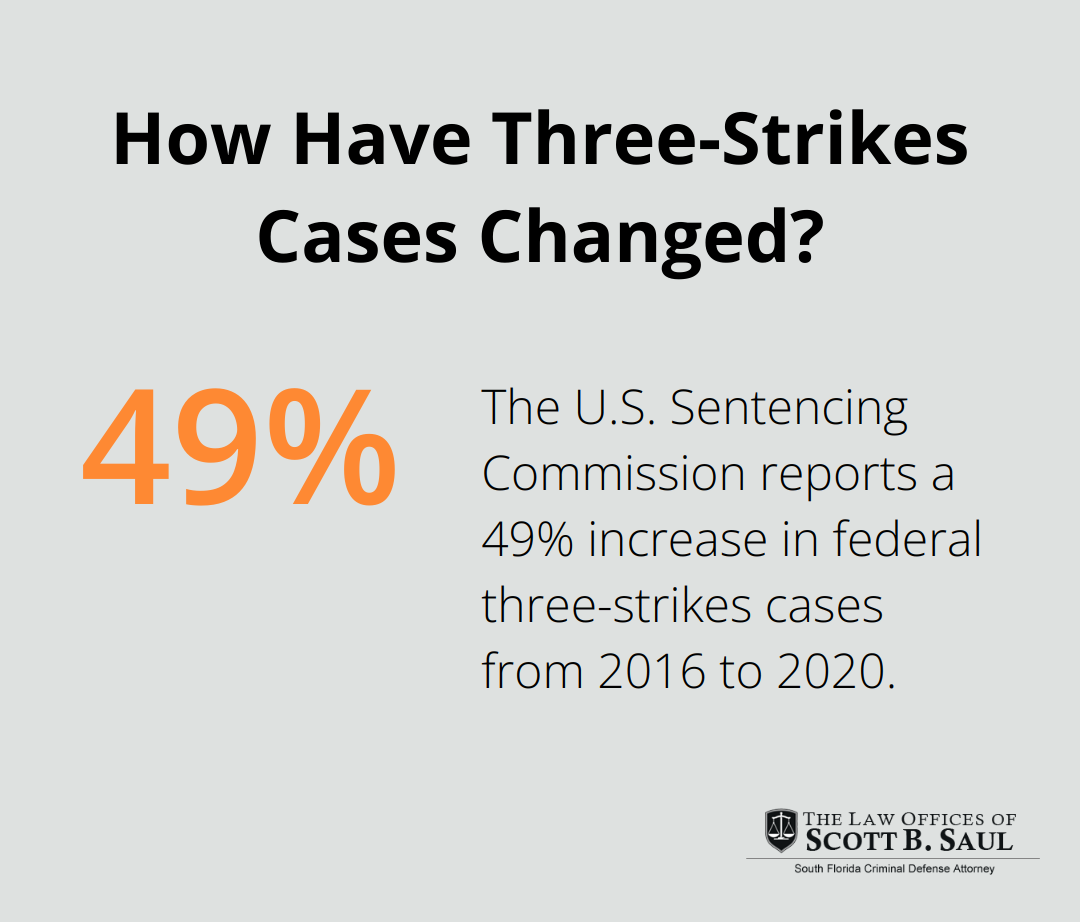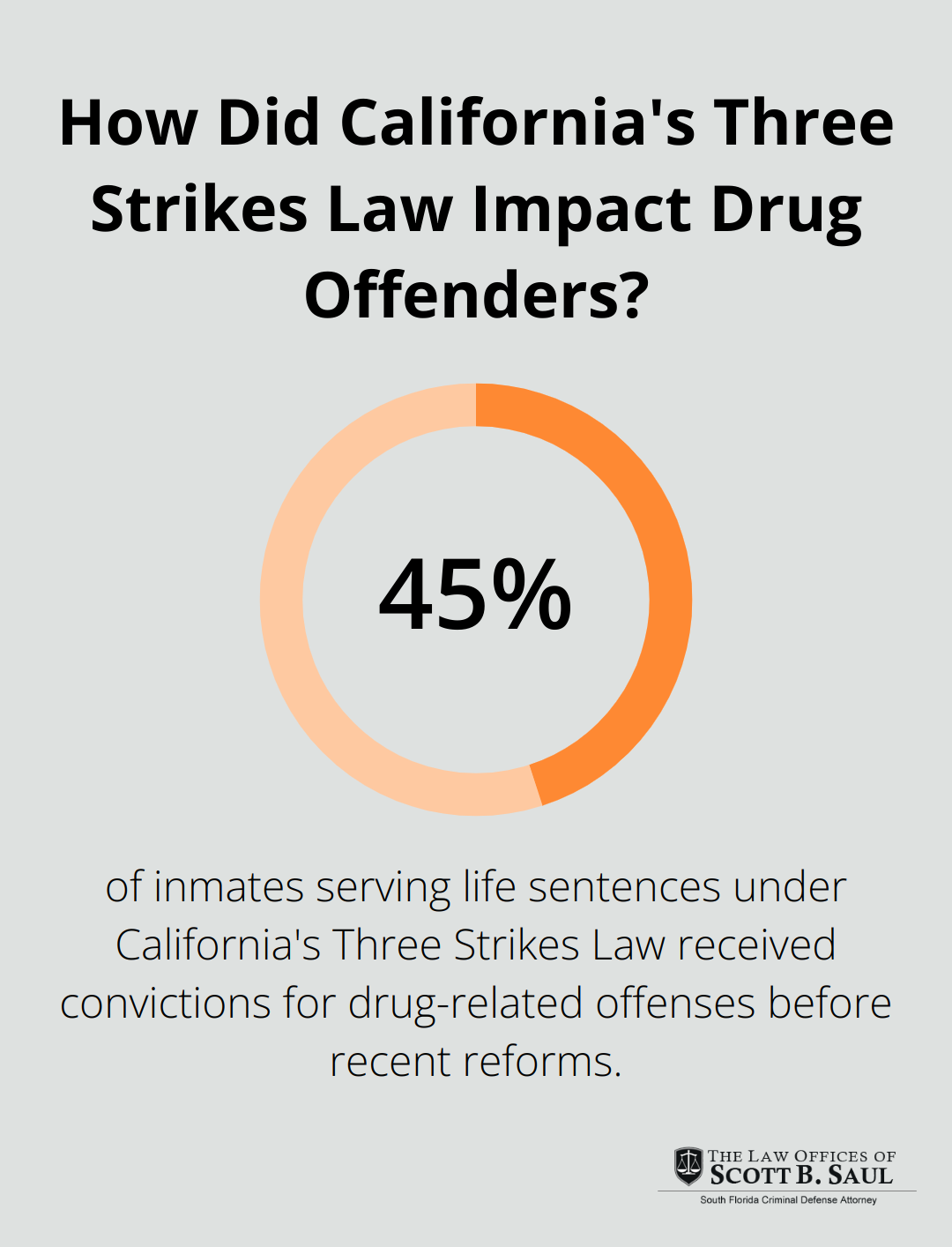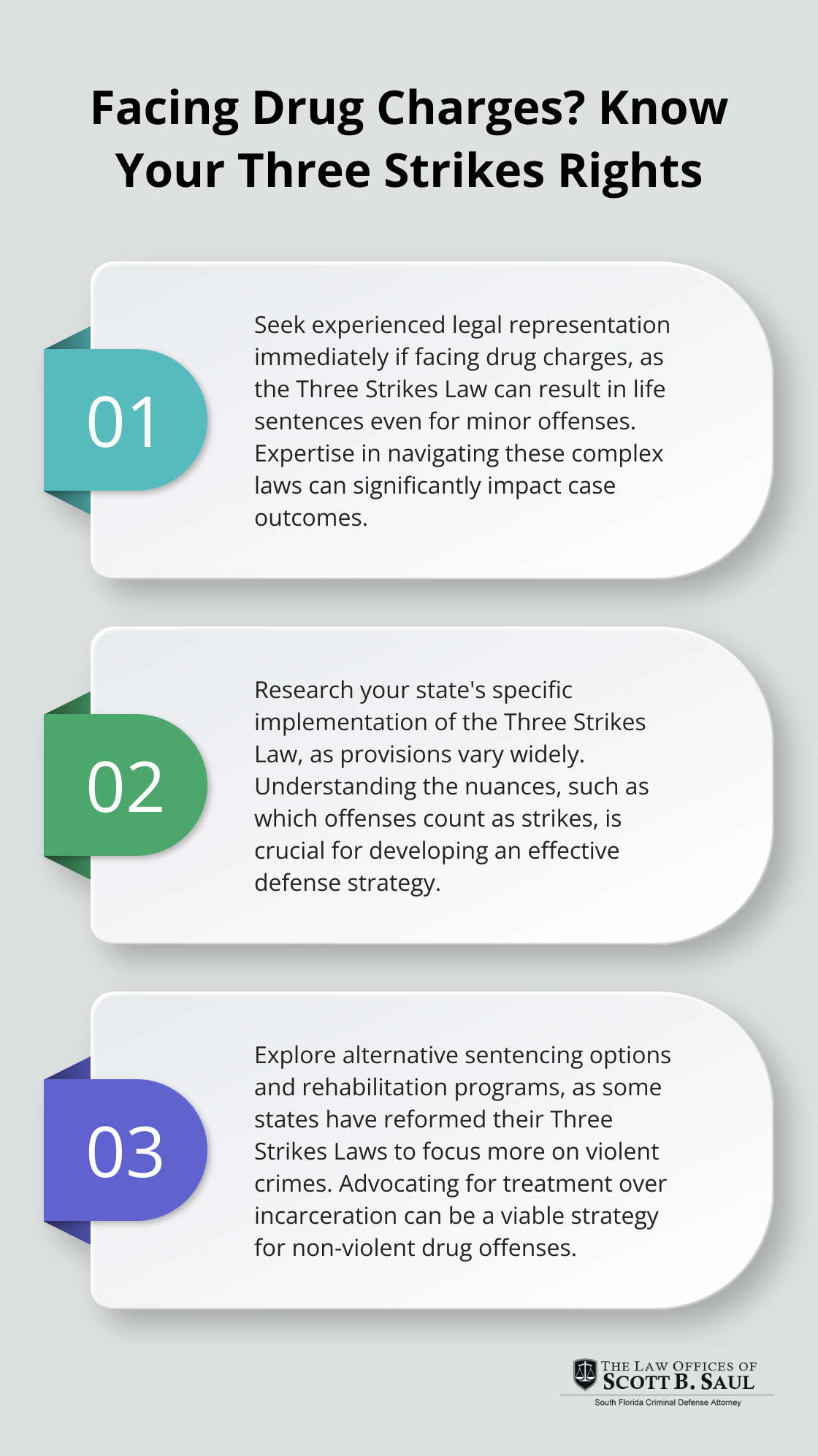Three Strikes Law: Impact on Drug-Related Crimes
By : saulcrim | Category : Criminal Defense | Comments Off on Three Strikes Law: Impact on Drug-Related Crimes
4th Jan 2025

The Three Strikes Law has significantly shaped the landscape of criminal justice in the United States, particularly in its approach to drug-related offenses. At Law Offices of Scott B. Saul, we’ve witnessed firsthand the profound impact this legislation has had on individuals facing drug charges.
This controversial law, implemented in various states, has sparked intense debate about its effectiveness and fairness in addressing drug crimes. In this post, we’ll explore how the Three Strikes Law affects drug offenses and examine its broader implications for the criminal justice system.
What is the Three Strikes Law?
The Three Strikes Law, enacted in 1994, fundamentally altered the U.S. criminal justice system’s approach to repeat offenders. This legislation mandates harsher sentences for individuals convicted of three felonies, including drug-related offenses.
Origins and Spread
California pioneered the Three Strikes Law in response to high-profile violent crimes. The law quickly gained traction, with 26 states and the federal government adopting similar legislation by 2004. Each state’s version differs, but the core principle remains: escalating penalties for repeat offenders.
Key Provisions
The law’s severity depends on the state. In California, a third felony conviction can result in a 25-years-to-life sentence, even for non-violent offenses. Other states focus on violent crimes for the third strike. The U.S. Sentencing Commission reports a 49% increase in federal three-strikes cases from 2016 to 2020, highlighting the law’s continued impact.
State Variations
While the basic framework is similar, state implementations differ significantly. For example:
- Georgia’s law applies only to seven specific violent felonies
- California’s initially included any felony as a potential third strike
- New York’s version (known as the “Persistent Felony Offender Law”) gives judges more discretion in sentencing
Application to Drug Offenses
The Three Strikes Law’s application to drug offenses varies widely across states. In some jurisdictions, drug possession can count as a strike, while others require intent to distribute. This inconsistency leads to disparate outcomes across state lines for similar offenses.

Understanding these nuances proves essential for effective defense strategies, especially in drug-related cases where the line between felony and misdemeanor can be thin. The law’s impact on drug offenses raises questions about its effectiveness and fairness, which we’ll explore in the next section.
How Does Three Strikes Impact Drug Offenses?
Altered Sentencing Landscape
The Three Strikes Law has dramatically changed the sentencing landscape for drug-related offenses. This shift often results in harsher sentences and longer prison terms, with far-reaching consequences for individuals and the criminal justice system.

Under this law, drug offenses can trigger severe penalties, even for relatively minor infractions. In California, a third felony conviction (including drug possession) can result in a 25-years-to-life sentence. This marks a stark departure from previous sentencing guidelines, where judges had more discretion in considering the specifics of each case.
Federal Impact on Drug Cases
According to the Bureau of Justice Statistics, the Drug Enforcement Administration (DEA) made 3,138 arrests for fentanyl, 2,591 arrests for heroin, and 676 arrests for other opioid offenses in fiscal year 2021. These statistics highlight the significant impact of drug-related crimes on federal law enforcement efforts.
Disproportionate Effects on Minority Communities
The Three Strikes Law has disproportionately affected drug offenders, particularly those from minority communities. A report by the Sentencing Project examines three causes of racial disparity in imprisonment and presents a series of promising reforms from over 50 jurisdictions across the country.
This disparity becomes further exacerbated by the Three Strikes Law. In California, before recent reforms, 45% of inmates serving life sentences under the law received convictions for drug-related offenses. This statistic highlights the law’s severe impact on drug offenders and raises questions about its fairness and effectiveness in addressing drug-related crimes.
Sentencing Comparison: Pre and Post Implementation
The implementation of the Three Strikes Law has led to a significant increase in sentence lengths for drug offenses. Prior to the law, a typical sentence for drug possession might range from probation to a few years in prison. Now, under Three Strikes, the same offense could result in a life sentence if it’s the offender’s third strike.
A high-profile case in California illustrates this drastic shift: a man received a 25-years-to-life sentence for stealing three golf clubs, due to prior drug convictions. This case exemplifies the potential for severe outcomes in drug-related cases under the Three Strikes Law.
The increased stakes make it more important than ever for individuals facing drug charges to seek experienced legal representation. Expertise in navigating these complex laws can make a significant difference in case outcomes, potentially helping clients avoid the harsh penalties associated with Three Strikes convictions.
As we examine the impact of the Three Strikes Law on drug offenses, it becomes clear that this legislation has sparked considerable controversy and criticism. The next section will explore these contentious aspects in detail, shedding light on the ongoing debate surrounding this law.
Unintended Consequences of Three Strikes
The Three Strikes Law, intended to deter crime, has led to several unintended consequences that have sparked intense debate and criticism. These issues have particularly affected drug-related offenses, raising questions about the law’s effectiveness and fairness.
Racial Disparities in Sentencing
One of the most significant criticisms of the Three Strikes Law is its disproportionate impact on minority communities. African-American offenders were significantly more likely than whites and Latinos to receive third-strike sentences, regardless of the nature of their offense. This stark imbalance has prompted calls for reform and reevaluation of the law’s application in drug cases.
Prison Overcrowding and Fiscal Strain
The implementation of the Three Strikes Law has contributed significantly to prison overcrowding and increased correctional costs. Three Strikes has increased the sentence length of a significant proportion of the inmate population, resulting in a growing and aging prison population.

The financial burden of this increase is substantial. This fiscal strain has forced states to divert funds from other critical areas (such as education and healthcare) to support the growing prison population.
Questionable Effectiveness in Crime Reduction
Despite its intended purpose, the effectiveness of the Three Strikes Law in reducing drug-related crimes remains a subject of debate. A study by the Justice Policy Institute found no significant difference in crime rates between states with and without Three Strikes laws.
Some experts argue that the law may have unintended negative effects. The threat of long sentences for relatively minor drug offenses can lead to more violent confrontations between suspects and law enforcement, as individuals facing their third strike may act more desperately to avoid arrest.
Impact on Non-Violent Offenders
The harsh penalties under Three Strikes often overshadow the potential for rehabilitation, particularly for non-violent drug offenders. This approach not only affects individuals but also has broader societal implications (potentially perpetuating cycles of addiction and incarceration rather than addressing the root causes of drug-related crimes).
Legal Complexities and Defense Challenges
The Three Strikes Law has introduced new complexities into drug-related cases. Defendants now face significantly higher stakes, making the need for experienced legal representation more critical than ever. Attorneys must navigate intricate legal waters to ensure fair treatment under the law and explore all possible avenues for their clients.
Final Thoughts
The Three Strikes Law has significantly altered the landscape of drug-related offenses, leading to longer sentences and increased prison populations. Several states have modified their laws to focus more on violent offenses, excluding certain non-violent drug crimes from triggering a third strike. This change reflects growing concerns about the law’s broad application and its potential to impose life sentences for relatively minor drug offenses.

Current trends in Three Strikes legislation show a shift towards reform, with potential alternatives gaining traction. These include emphasizing rehabilitation over punishment for non-violent drug offenders and implementing more flexible sentencing guidelines. Some advocates propose eliminating drug possession as a strike-eligible offense entirely, focusing instead on more serious drug trafficking crimes.
The complexity of Three Strikes cases, especially those involving drug offenses, underscores the importance of experienced legal representation. At Law Offices of Scott B. Saul, we bring over three decades of criminal defense expertise to navigate these challenging legal waters. Our firm’s experience in handling cases involving tourists and foreign travelers (combined with our strong track record in jury trials) positions us uniquely to defend clients facing charges under the Three Strikes law for drug offenses.
Archives
- July 2025 (2)
- June 2025 (9)
- May 2025 (9)
- April 2025 (8)
- March 2025 (9)
- February 2025 (8)
- January 2025 (9)
- December 2024 (10)
- November 2024 (5)
- July 2024 (2)
- June 2024 (2)
- May 2024 (2)
- April 2024 (2)
- March 2024 (2)
- February 2024 (2)
- January 2024 (2)
- December 2023 (2)
- November 2023 (2)
- October 2023 (2)
- September 2023 (2)
- August 2023 (1)
- July 2023 (2)
- June 2023 (2)
- May 2023 (2)
- April 2023 (2)
- March 2023 (2)
- February 2023 (2)
- January 2023 (2)
- December 2022 (2)
- November 2022 (2)
- October 2022 (2)
- September 2022 (2)
- August 2022 (2)
- July 2022 (2)
- June 2022 (2)
- May 2022 (2)
- April 2022 (2)
- March 2022 (2)
- February 2022 (2)
- January 2022 (2)
- December 2021 (2)
- November 2021 (2)
- October 2021 (2)
- September 2021 (2)
- August 2021 (2)
- July 2021 (2)
- June 2021 (2)
- May 2021 (2)
- April 2021 (2)
- September 2020 (5)
- July 2020 (4)
- June 2020 (4)
- May 2020 (4)
- April 2020 (5)
- March 2020 (4)
- February 2020 (4)
- January 2020 (4)
- December 2019 (1)
- November 2019 (4)
- October 2019 (4)
- September 2019 (4)
- August 2019 (4)
- July 2019 (5)
- June 2019 (4)
- May 2019 (4)
- April 2019 (4)
- March 2019 (4)
- February 2019 (4)
- January 2019 (4)
- December 2018 (4)
- November 2018 (5)
- October 2018 (5)
- September 2018 (4)
- August 2018 (4)
- July 2018 (7)
- June 2018 (4)
- May 2018 (4)
- April 2018 (8)
- March 2018 (4)
- February 2018 (4)
- January 2018 (4)
- November 2017 (4)
- October 2017 (4)
- September 2017 (4)
- August 2017 (7)
- July 2017 (6)
- June 2017 (4)
- May 2017 (4)
- April 2017 (4)
- March 2017 (4)
- February 2017 (7)
- January 2017 (4)
- December 2016 (7)
- November 2016 (4)
- October 2016 (4)
- September 2016 (10)
- August 2016 (4)
- July 2016 (4)
- June 2016 (4)
- May 2016 (4)
- April 2016 (4)
- March 2016 (4)
- February 2016 (7)
- January 2016 (4)
- December 2015 (5)
- November 2015 (4)
- October 2015 (7)
- September 2015 (4)
- August 2015 (4)
- July 2015 (13)
- June 2015 (9)
- May 2015 (8)
- April 2015 (6)
- March 2015 (4)
- February 2015 (4)
- January 2015 (4)
- December 2014 (4)
- November 2014 (4)
- October 2014 (4)
- September 2014 (3)
Categories
- Adjudication (1)
- Bankruptcy (1)
- Burglary Crimes (3)
- calendar call (1)
- Car Accident (1)
- Criminal Defense (333)
- Cyber Crimes (7)
- DNA (1)
- Domestic Violence (9)
- Drug Crimes (5)
- DUI (12)
- Embezzlement (1)
- Environmental Crimes (4)
- Expungement Law (2)
- Federal Sentencing Law (3)
- Firearm (3)
- Forgery (4)
- General (82)
- Healthcare (3)
- Immigration (1)
- Indentity Theft (1)
- Insurance (5)
- judicial sounding (2)
- Juvenile Crimes (4)
- Manslaughter (4)
- Money Laundering (3)
- Organized Crime (1)
- Racketeering (1)
- Reckless Driving (3)
- RICO (3)
- Sealing and Expunging (2)
- Sex Offense (1)
- Shoplifting (1)
- Suspended Driver's License (1)
- Traffic (4)
- Trending Topics (1)
- White-collar Offenses (1)

